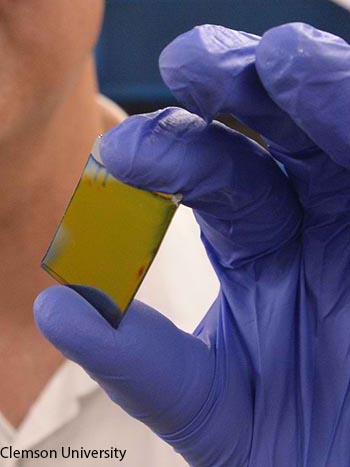
Igor Luzinov holds a mid-IR sensing chip with a coating that changes its topography upon exposure to chemicals used to fabricate weapons banned in international treaties.
A team of U.S. researchers at Clemson University, Massachusetts Institute of Technology, Physical sciences and the University of Central Florida’s College of Optics and Photonics (CREOL) are developing a tamper-resistant coating on chalcogenide glass photonics structures on-chip (Soft Matter, doi: 10.1039/C4SM00055B). The chip’s special coating could help detect changes at the nanoscale level when exposed to target chemicals. International weapons inspectors could use the one-inch-square chip as a tool to detect weapons banned in treaties.
Igor Luzinov, professor of materials science and engineering at Clemson, says the chip would be used in laboratories to passively detect chemicals used in fabricating banned weapons. Inspectors would place the chip in a lab and collect it about once a month to detect any changes. The foam would collapse upon exposure to chemicals used in such weapons.
The mid-infrared lab-on-a-chip under the foam coating combines a light source, sensing elements, a detector and read-out circuitry on a monolithic silicon platform. The team produces the film by first stretching it over the silicon chip and freezing it, then infusing it with a solvent that turns into the thin nanofilm. Researchers can obtain an accurate profile of the foam’s topography via an optical microresonator array. Any tampering would be evident to scientists.
The project is funded with $1.4 million from the U.S. Defense Threat Reduction Agency, and is expected to be complete in two years. The next step is to perfect the concentration of vapors in the foam so that it can be made more sensitive.
